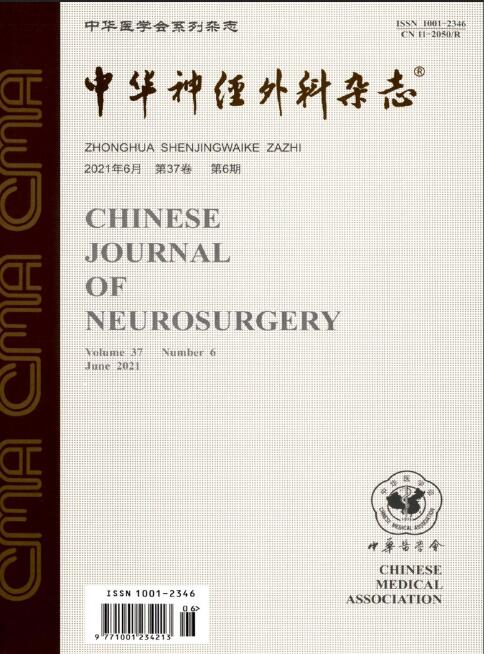丘脑下深部脑刺激治疗帕金森病的编程参数分析
Q4 Medicine
引用次数: 2
摘要
目的分析丘脑下核(STN)深部脑刺激(DBS)治疗帕金森病后刺激参数的变化。方法回顾性分析2011年11月至2017年6月武汉大学中南医院神经外科采用STN-DBS治疗的95例帕金森病患者的临床资料。95例患者的刺激参数为:单极刺激为主(98.3%,175/178),刺激触点主要位于上STN(90.9%, 171/188),单触点刺激居多(94.4%,168/178)。分别在3个月、6个月、1年和2年对患者进行评估。主要评价指标包括术后参数、统一帕金森病评定量表Ⅲ(UPDRS-Ⅲ)、改善率[(术前评分-术后评分)/术前评分× 100%]、刺激能量(voltage2×frequency×pulsewidth/impedance×1 s)、刺激相关不良事件。结果根据术中微电极记录和术后MRI图像,95例患者电极植入预设靶点。UPDRS-Ⅲ评分为(12.7±6.7)分,优于术前(P<0.05),改善率为(70.7±12.1)%。随访期间,UPDRS-Ⅲ的改善率逐渐下降(F=2.421, P=0.048)。电压逐渐增大(F=24.633, P<0.001),脉宽略有增大(F=3.118, P=0.015),但频率变化不显著(F=1.332, P=0.257)。能量逐渐增加(P<0.05),无痕带(ZI)触点逐渐增加(P<0.05),双极刺激轻微增加(P<0.05),双极触点逐渐增加(P<0.05)。随访期间,共有35例患者出现刺激相关不良事件,其中有14例出现麻烦的运动障碍,4例出现步态障碍或不平衡,1例出现焦虑和抑郁,2例出现吞咽困难或饮性咳嗽,8例出现幻觉,1例出现精神分裂症,2例兴奋性增高,1例出现睁眼困难。结论STN- dbs治疗帕金森病时,随着时间的推移,刺激电压和能量逐渐升高,双触点刺激方式逐渐增多,但仍以单极刺激为主,STN上部为最佳刺激部位。关键词:帕金森病;丘脑核;脑深部电刺激;术后编程本文章由计算机程序翻译,如有差异,请以英文原文为准。
Programming parameter analysis of subthalamic deep brain stimulation for the treatment of Parkinson′s disease
Objective
To analyze the changes in stimulation parameters post subthalamic nucleus(STN) deep brain stimulation (DBS) for the treatment of Parkinson′s disease.
Methods
Ninety-five cases of patients with Parkinson′s disease treated with STN-DBS at Department of Neurosurgery, Zhongnan Hospital of Wuhan University from November 2011 to June 2017 were analyzed retrospectively. The stimulation parameters of 95 patients were as follows: the monopolar stimulation was main (98.3%, 175/178), The stimulus contacts were mainly in the upper STN (90.9%, 171/188), and most of them were single contact stimulation (94.4%, 168/178). Patients were evaluated in 3 months, 6 months, 1 year and 2 years. The primary outcome was assessed included the post-operation parameters, the unified Parkinson′s disease rating scale Ⅲ(UPDRS-Ⅲ), the improvement rate[(preoperative score-postoperative score) / preoperative score × 100%], the stimulus energy(voltage2×frequency×pulsewidth/impedance×1 s), the stimulation-related adverse events.
Results
The electrodes of 95 patients were implanted into preset targets based on intraoperative microelectrode recording and postoperative MRI images.The score of UPDRS-Ⅲ was (12.7 ±6.7)points, which was better than that before operation(P<0.05), and the improvement rate was (70.7±12.1)%. During the follow-up period, the improvement rate of UPDRS-Ⅲ decreased gradually (F=2.421, P=0.048). The voltage increased gradually (F=24.633, P<0.001), the pulse width increased slightly (F=3.118, P=0.015), but the frequency did not change significantly (F=1.332, P=0.257). The energy increased gradually (P<0.05), the contacts in zona incerta (ZI) increased gradually (P<0.05), the bipolar stimulation increased slightly (P<0.05), and the double contacts gradually increased gradually (P<0.05). During the follow-up period, a total of 35 patients developed stimulation-related adverse events, including 14 patients with troublesome dyskinesia, 4 patients with gait disorder or disequilibrium, 1 patients with anxiety and depression, 2 patients with dysphagia or drinking cough, 8 patients with hallucinations, 1 patient with hypophrenia, 2 patients with increased excitability, 1 patient with eye opening difficulty.
Conclusions
With the passage of time in the treatment of Parkinson′s disease with STN-DBS, the stimulation voltage and energy increased gradually, and the stimulation mode of double contacts increased gradually, but it was still dominated by unipolar stimulation, and the upper part of STN is the best stimulus site.
Key words:
Parkinson disease; Subthalamic nucleus; Deep brain stimulation; Post-operation programming
求助全文
通过发布文献求助,成功后即可免费获取论文全文。
去求助
来源期刊

中华神经外科杂志
Medicine-Surgery
CiteScore
0.10
自引率
0.00%
发文量
10706
期刊介绍:
Chinese Journal of Neurosurgery is one of the series of journals organized by the Chinese Medical Association under the supervision of the China Association for Science and Technology. The journal is aimed at neurosurgeons and related researchers, and reports on the leading scientific research results and clinical experience in the field of neurosurgery, as well as the basic theoretical research closely related to neurosurgery.Chinese Journal of Neurosurgery has been included in many famous domestic search organizations, such as China Knowledge Resources Database, China Biomedical Journal Citation Database, Chinese Biomedical Journal Literature Database, China Science Citation Database, China Biomedical Literature Database, China Science and Technology Paper Citation Statistical Analysis Database, and China Science and Technology Journal Full Text Database, Wanfang Data Database of Medical Journals, etc.
 求助内容:
求助内容: 应助结果提醒方式:
应助结果提醒方式:


